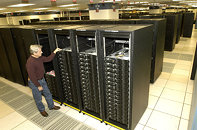Monday, June 9th 2008

IBM Designed Military Supercomputer Sets New Record
A government computer in New Mexico is the first supercomputer to perform at one petaflop (one thousand trillion calculations per second). Located at the Los Alamos National Laboratory of the Department of Energy's National Nuclear Security Administration, Roadrunner is twice as fast as IBM Blue Gene system at Lawrence Livermore National Lab, which was until now the fastest computer in the world. The new supercomputer is designed and built by IBM using both traditional computer chips and IBM's Cell Broadband Engine. Roadrunner occupies 6,000 square feet and weighs 500,000 lbs. It is also aiming to take place among the top energy-efficient systems on the official "Green 500" list of supercomputers. Roadrunner will be used primarily to ensure the safety and reliability of the U.S. nuclear weapons stockpile. It will also do research into astronomy, energy, human genome science and climate change. Learn more here.
Source:
IBM

35 Comments on IBM Designed Military Supercomputer Sets New Record
how much does it cost?
Still impressive, though
What happens is that the network needs to be managed with a scheduler and marshaller to send "task" over ethernet to each blade. So if you can partition a problem so that separate blades can do different INDEPENDENT calculations, then great.
In other words, its really a fancy "folding at home" but in one room with better interconnect. F@H is currently achieving 2.0 Petaflops at ACTUAL software delivered performance, over 300,000 active CPUs. fah-web.stanford.edu/cgi-bin/main.py?qtype=osstats
The F@H network is more actual performance than Roadrunner in terms of theoretic CPU flops. That's pretty cool for F@H.
K
EDIT: Oh and BTW. The only difference between these "new-style supercomputers" and the "good-old supercomputers" is that the new ones use "standard" open net protocol such as Ethernet instead of the propietary-made-only-for-that-computer ones used in previos supercomputers. The working mechanism is the same.
Good stuff, New Mexico is a great place for high tech research and industry, the more the better.
and i was wondering when ibm would put together a cell based supercomputer (which would obviously be faster then the ppc-based bluegenes)
looks like this is part of the amd-ibm deal a while back
Pricing for COTS has just made Cluster supercomputing so cheap relative to SIMD and Vector that SIMD and Vector is essentially dead. However, if you have a SIMD or vector type problem and try to cluster it you hit von Neumann very fast where the marginal gain from an extra node has exponentially decreasing returns.
Anyone want to build their own supercomputer?
www.ibiblio.org/pub/linux/docs/HOWTO/archive/Beowulf-HOWTO.html
www.beowulf.org/overview/index.html
EDIT 1 minute or less